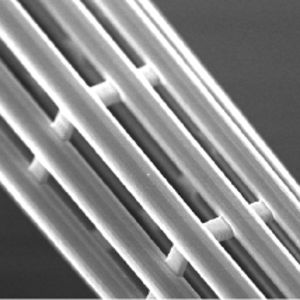Quantum technologies: Hollow-core light cage on a chip
31 May 2021
A German-British research team has developed an on-chip hollow-core light cage that could provide a platform for quantum-storage and quantum-nonlinear applications.
31 May 2021
A German-British research team has developed an on-chip hollow-core light cage that could provide a platform for quantum-storage and quantum-nonlinear applications.

Hollow-core light-cage
In the rapidly growing field of hybrid quantum photonics, the realization of miniaturized, integrated quantum-optical systems with intense light-matter interaction is of great importance for both fundamental and applied research. In particular, the development of methods for reliably generating, controlling, storing and retrieving quantum states with high fidelity through coherent interaction of light and matter opened up a wide field of applications for quantum information and quantum networks. These include, for example, optical switching, quantum memories, and quantum repeaters.
One promising approach for efficient light-matter interaction is the integration of light-guiding platforms in a near-room-temperature alkali vapor. Several research groups have aimed to interface hollow-core photonic-crystal fibers or planar waveguides with atoms in vapor cells. However, when coupled to atoms, nearly all photonic structures reveal distinct limitations imposed by their design or they induce an unwanted level of complexity, especially when aiming for integrated applications.
In a new paper a team of scientists from Ludwig-Maximilians-Universität München, Humboldt-Universität zu Berlin, Leibniz Institute of Photonic Technology and Friedrich Schiller University, Jena, the University of Stuttgart, and Imperial College London has integrated a novel on-chip hollow-core light cage into an alkali atom vapor cell. This altogether overcomes the disadvantages of previously explored photonic structures, potentially providing a basis for quantum-storage and quantum-nonlinear applications.
The researchers adopted the compact, easy-to-handle light-guiding structure of the laterally-accessible light cage as a container for coherent light-matter interaction, thus realizing stable non-degrading performance and extreme versatility. As a result, the observation of electromagnetically-induced transparency, a prominent quantum-optical effect, inside the novel on-chip hollow-core light cage demonstrates its potential for applications in quantum optics.
Implemented by 3D nanoprinting, the compact light cage on a chip exhibits several advantages compared to other hollow-core waveguide structures. Whereas hollow-core fibers or planar waveguides suffer from inefficient vapor-filling times — exceeding months for few centimeter long devices — the design of the light cage allows for high-speed gas diffusion through side-wise direct access to the hollow core within minutes.
Moreover, the high degree of integration and long-term stability allows for interfacing the device with other established technology platforms like silicon photonics and fiber optics, as well as customizing reproducible devices for a large variety of applications.
„We demonstrate the peculiar coherent quantum-optical interaction between the light field in a light cage and room-temperature cesium vapor. This is the first time we have succeeded in observing electromagnetically induced transparency inside such a structure“, Tim Kroh from the Department of Physics at Humboldt-Universität zu Berlin explains.
„Apart from the beautiful physics that went into the discovery and design of the light cage, and the quantum optics experiment conducted with it, the technique we used for fabricating the light cage is fascinating — directly writing it into a polymer block with a laser beam. This very versatile method has a great future for integrated optical devices“, adds Prof. Dr. Stefan Maier, who is holding the Chair in Hybrid Nanosystems at Ludwig-Maximilians-Universität München.
Further improvements of the structure are straightforward, the researchers say. The generation of broad electromagnetically-induced transparency windows for light delay of spectrally broad light pulses, as emitted from single-photon sources, lays a foundation to synchronize photon arrival in quantum networks or to realize compact quantum storage on-a-chip. „Therefore our results represent a major step forward by an unprecedented hybrid integration of designer laser-written structures and atom cells. The freedom to produce three-dimensional structures nearly without restrictions on the silicon-technology platform will allow us to combine light-matter interaction in the light cage with other Si-chip-compatible devices, i.e. lithium niobate waveguides for modulation and frequency conversion of light, as well as direct mode coupling from and to optical fibers. Extensive control of the single-photon properties in a quantum network could ultimately be applied all on one chip“, the scientists forecast.
Light: Science & Applications, 2021.